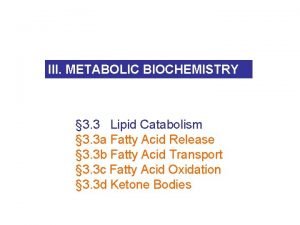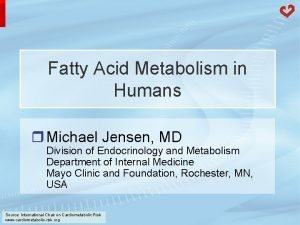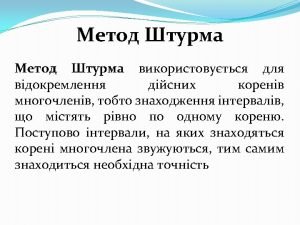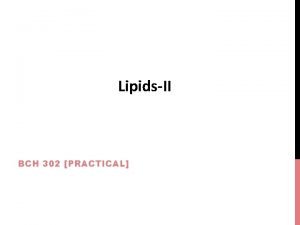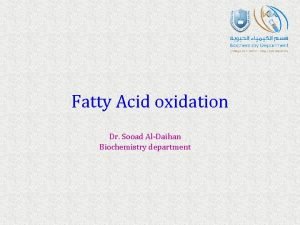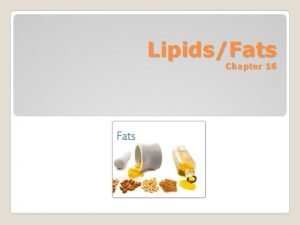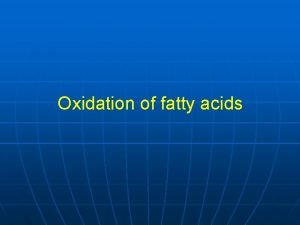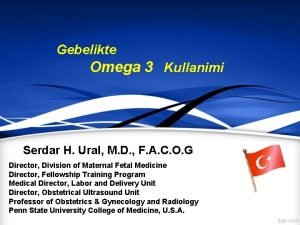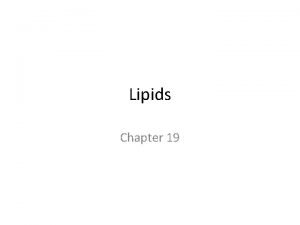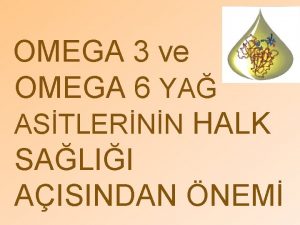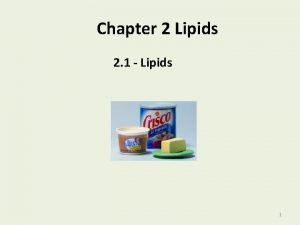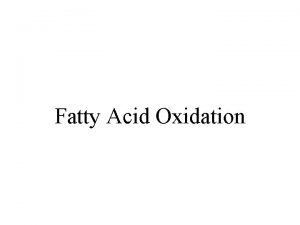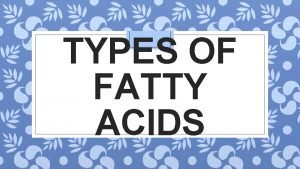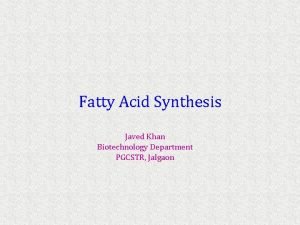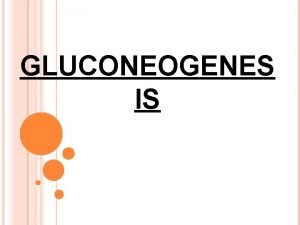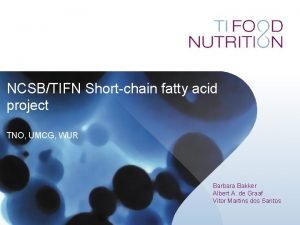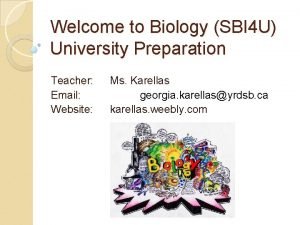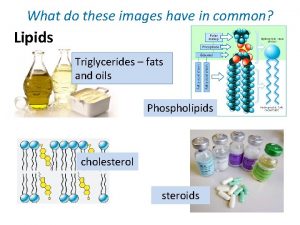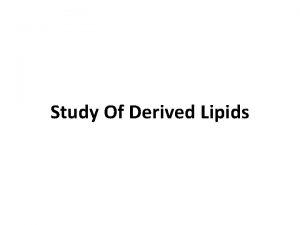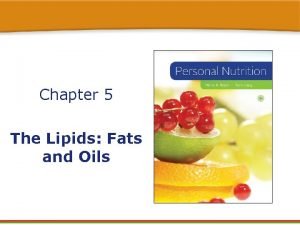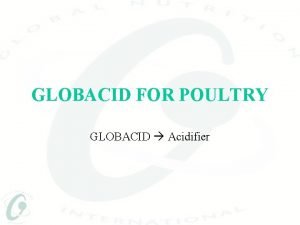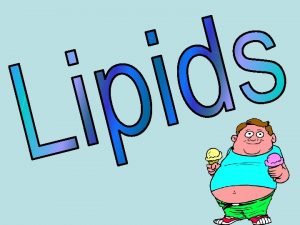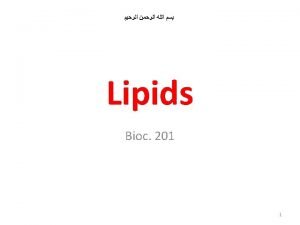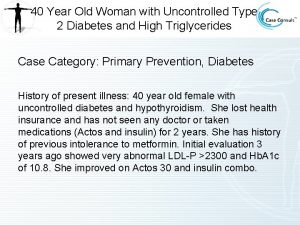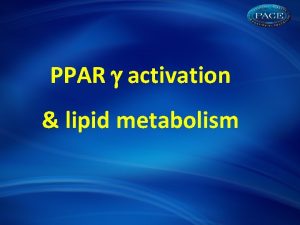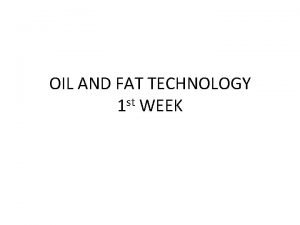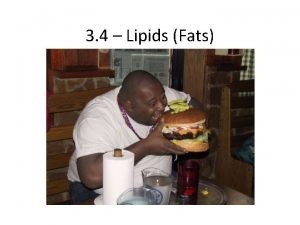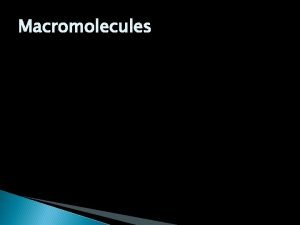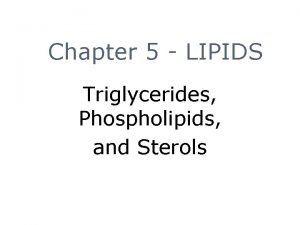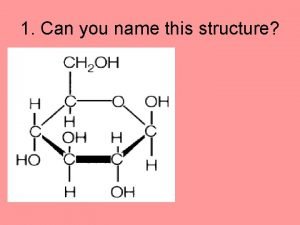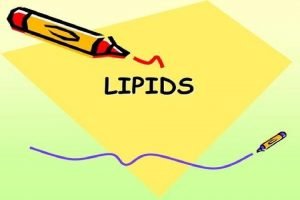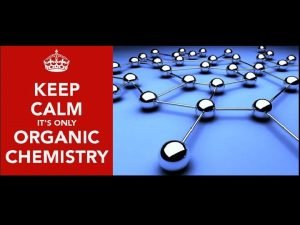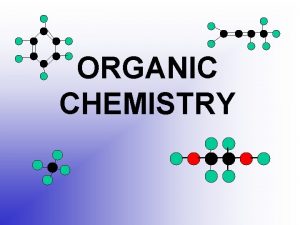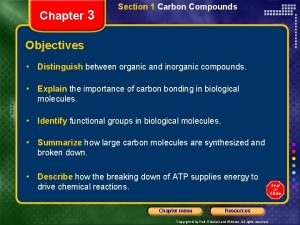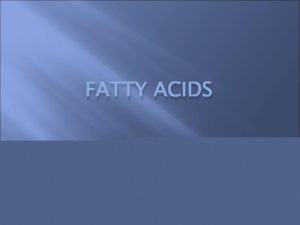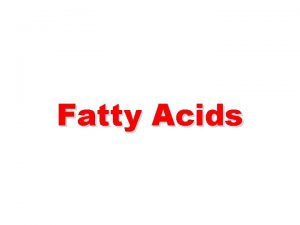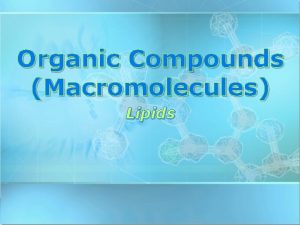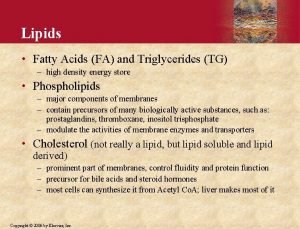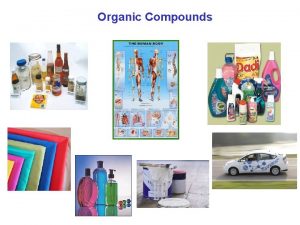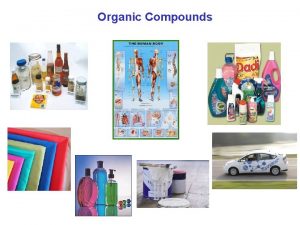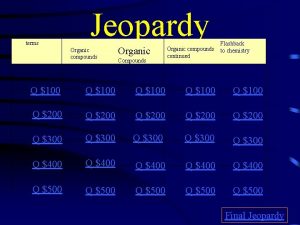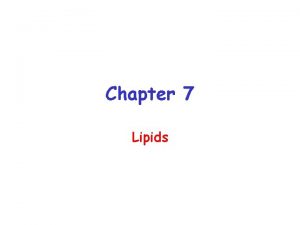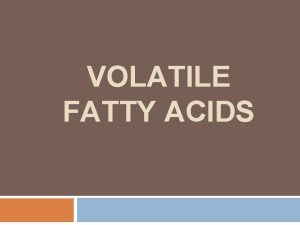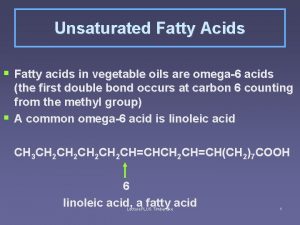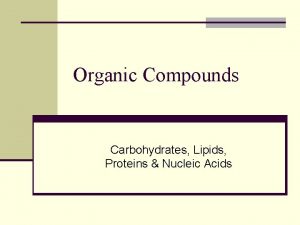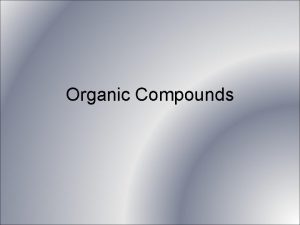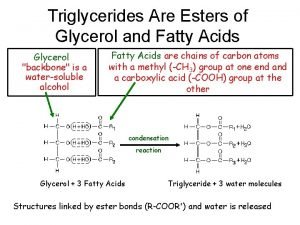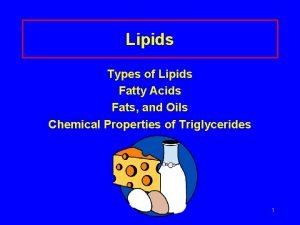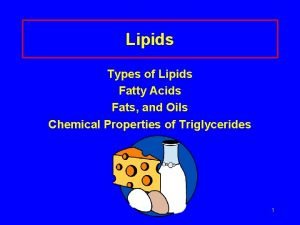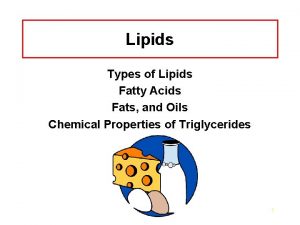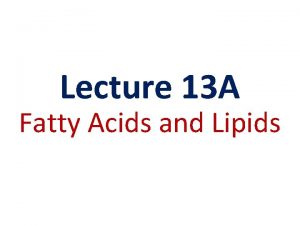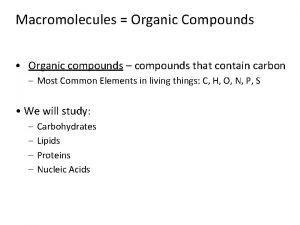Lipids ORGANIC COMPOUNDS Lipids Include fatty acids triglycerides











































- Slides: 43

Lipids ORGANIC COMPOUNDS

Lipids Include fatty acids, triglycerides, phospholipids, steroids, eicosanoids, and vitamins A, E, and K Represent 18 -25% of your body mass Contain C, H, O, and sometimes P Most are hydrophobic Lipoproteins

Fatty Acids The simplest lipids • Used to synthesize triglycerides and phospholipids • Can be catabolized to generate ATP • Composed of a carboxyl group and a hydrocarbon chain • Can either be saturated or unsaturated

Fatty Acids Saturated fatty acids Unsaturated fatty acids • Single covalent bonds between the carbon atoms • Double covalent bonds between the carbon atoms • Monounsaturated = 1 double bond • Polyunsaturated = 2+ double bonds

Figure 2. 17 asynthesis

Triglycerides Structure • 1 molecule of glycerol and 3 fatty acids • Formed by dehydration synthesis • Broken down by hydrolysis Function • Energy storage (adipose tissue); can be catabolized to generate ATP • Protection and insulation

Triglycerides • Classified according to the fatty acids: Saturated • Solid at room temp • Common in animal fats and non-skim dairy • Cocoa butter, palm oil, coconut oil • Increase risk of heart disease and colorectal cancer Unsaturated • Liquid at room temp • Common in plant oils • Monounsaturated – olive, peanut, and canola oil, nuts, avocados • Polyunsaturated – corn, safflower, sunflower and soybean oil, fatty fish • Decrease risk of heart disease

Figure 2. 17 is Read Clinical Connection: Fatty Acids in Health and Disease for an excellent discussion of essential fatty acids and transfatty acids.

Phospholipids Structure • Composed of glycerol, 2 fatty acid molecules, and 1 phosphate group (PO 43 -) • The phosphate group is polar and can form hydrogen bonds with water - it is hydrophilic • The 2 fatty acid tails are nonpolar and cannot form hydrogen bonds with water - they are hydrophobic Function • Amphipathic phospholipids line up tail-to-tail in a double row to form cell membranes

Figure 2. 18 Phospholipids

Steroids Composed of 4 rings of carbon atoms. Cholesterol Bile salts Vitamin D Adrenocortical hormones Sex hormones

Figure 2. 19 Steroids

Eicosanoids Derived from arachidonic acid • Prostaglandins modify responses to hormones, contribute to inflammation, dilate lung airways, regulate body temperature, and influence blood clotting • Leukotrienes participate in allergic and inflammatory responses

Fat-Soluble Vitamins Vitamin A • Needed for vision • Antioxidant Vitamin E • • Promotes wound healing Prevents scarring Needed for nervous system function Antioxidant Vitamin K • Needed for synthesis of blood-clotting proteins

Table 2. 7 Types of Lipids in the Body

Proteins ORGANIC COMPOUNDS

Proteins Represent about 12 -18% of your body mass Three major groups based on their sizes: amino acids, peptides, and polypeptides Contain C, H, O, and N (and sometimes S)

Protein Functions Structural proteins • The basic structural material of the body • Ex. Keratin and Collagen Regulatory proteins • Function as hormones and neurotransmitters • Ex. Insulin and Substance P Contractile proteins • Allow shortening of muscle cells • Ex. Myosin and Actin

Protein Functions Immunological proteins • Protect the body against foreign invaders • Ex. Antibodies and Interleukins Transport proteins • Carry vital substances throughout the body • Ex. Hemoglobin Catalytic proteins • Act as enzymes • Ex. Salivary amylase, sucrose and ATPase

Amino Acids • The building blocks of protein • There are 20 different amino acids • Each amino acid has a hydrogen atom and three important functional groups attached to a central carbon atom – An amino group – An acidic carboxyl group – A side chain

Figure 2. 20 Amino acids

Peptides • Chains of 2 -9 amino acids linked together by peptide bonds • A peptide bond always forms between the carbon of the carboxyl group of one amino acid and the nitrogen of the amino group of another • Peptide bonds are formed by dehydration synthesis

Figure 2. 21 Formation of a peptide bond between two amino acids during dehydration synthesis

Polypeptides • Chains of 10 -99 amino acids linked together by peptide bonds • Some proteins are small (about 50 aa) • Most proteins are huge (100 – 2000 aa) and may consist of one polypeptide chain, or several folded together

Protein Structure Quaternary Structure Tertiary Structure Secondary Structure Primary Structure

Primary Structure • The unique linear sequence of amino acids linked by peptide bonds to form a polypeptide • Primary structure is genetically determined • Any change in primary structure can have serious consequences

Figure 2. 22 a Levels of structural organization in proteins

Secondary Structure • The repeated twisting or folding of neighboring amino acids in the polypeptide chain – Alpha-helixes (clockwise spirals) – Beta-pleated sheets • A polypeptide can exhibit one or both types of secondary structure • Secondary structure is stabilized by hydrogen bonds – Form at regular intervals along the polypeptide backbone

Tertiary Structure • The 3 -dimensional shape of a polypeptide chain • A protein with tertiary structure is functional – It’s tertiary structure determines its function • Tertiary structure is stabilized by disulfide bonds, hydrogen bonds, ionic bonds, and hydrophobic interactions • Chaperones aid the folding process

Quaternary Structure • The arrangement of the individual polypeptide chains relative to one another in proteins that contain more than one polypeptide chain – Only some proteins contain more than one polypeptide chain. – Those chains are called protein subunits and cannot function on their own. • Quaternary structure is stabilized by the same bonds that maintain tertiary structure

https: //www. yout ube. com/watch? v =lij. Q 3 a 8 y. UYQ

Enzymes Are proteins Speed up chemical reactions Have 3 important properties: Apoenzyme Highly specific cofactor Very efficient and fast Subject to cellular control

Figure 2. 23 a How an enzyme works

Table 2. 8 Functions of Proteins

Nucleic Acids ORGANIC COMPOUNDS

Nucleic Acids Huge organic molecules Deoxyribonucleic acid (DNA) • Forms the inherited genetic material (genes) inside each human cell Ribonucleic acid (RNA) • Relays instructions from the genes to guide protein synthesis Contain C, H, O, N, and P

DNA Nucleotides • The monomers of DNA • Each DNA nucleotide consists of 3 parts – Nitrogenous base; one of • • Adenine (A) Thymine (T) Cytosine (C) Guanine (G) – Pentose sugar; a 5 -carbon sugar called deoxyribose attached to each base – Phosphate group; alternate with pentose sugars to form DNA “backbone”

DNA Structure • DNA is double stranded • Phosphate groups and deoxyribose form the uprights of the ladder • Paired bases, held together by hydrogen bonds, form the rungs • Bonding of the bases is very specific – Adenine pairs with thymine via 2 hydrogen bonds – Cytosine pairs with guanine via 3 hydrogen bonds

Figure 2. 24 DNA molecule

RNA Nucleotides • The monomers of RNA • Each RNA nucleotide consists of 3 parts – Nitrogenous base; one of • • Adenine (A) Uracil (U) Cytosine (C) Guanine (G) – Pentose sugar; a 5 -carbon sugar called ribose attached to each base – Phosphate group; alternate with pentose sugars to form RNA “backbone”

RNA Structure • RNA is single stranded • Cells contain 3 different kinds of RNA, each of which has a specific role to perform during protein synthesis – Ribosomal RNA (r. RNA) – Messenger RNA (m. RNA) – Transfer RNA

Adenosine Triphosphate “Energy currency” Powers cellular activities such as Muscular contraction Organellar Movement within cells Membrane transport Protein synthesis

Figure 2. 25 Structures of ATP and ADP
 Fatty acids triglycerides
Fatty acids triglycerides Fatty acid oxidation
Fatty acid oxidation #include stdio.h #include conio.h #include stdlib.h
#include stdio.h #include conio.h #include stdlib.h Non essential fatty acids
Non essential fatty acids Beta oxidation
Beta oxidation What are triglycerides
What are triglycerides Activation of fatty acids
Activation of fatty acids Importance of lipids
Importance of lipids Essential fatty acids
Essential fatty acids Are lipids energy storage
Are lipids energy storage Essential non essential fatty acids
Essential non essential fatty acids Esansiyel yağ asitleri
Esansiyel yağ asitleri Steroid nucleus structure
Steroid nucleus structure Saturated fatty acids definition
Saturated fatty acids definition Types of fatty acids
Types of fatty acids Beta oxidation of fatty acids
Beta oxidation of fatty acids Pyruvate to lactate
Pyruvate to lactate Short chain fatty acids
Short chain fatty acids Ester bond in fatty acids
Ester bond in fatty acids What are triglycerides
What are triglycerides 3,5,8,11,16,19
3,5,8,11,16,19 Saturated vs unsaturated fatty acids
Saturated vs unsaturated fatty acids Beta oxidation
Beta oxidation Globacid
Globacid Triglycerides formation
Triglycerides formation Saponification of triglycerides
Saponification of triglycerides Triglycerides treatment
Triglycerides treatment Metformin triglycerides
Metformin triglycerides Dyslipidaemia
Dyslipidaemia Iodine value formula
Iodine value formula Triglycerides are composed of
Triglycerides are composed of Naming triglycerides
Naming triglycerides Triglycerides phospholipids and sterols
Triglycerides phospholipids and sterols What is the name of this picture
What is the name of this picture V
V What is the common name for (ch3)2choch2(ch2)3ch3?
What is the common name for (ch3)2choch2(ch2)3ch3? Group of carbon
Group of carbon Functional groups priority
Functional groups priority Biomolecule
Biomolecule What is a nucleotide
What is a nucleotide All organic compounds contain carbon and ________.
All organic compounds contain carbon and ________.
